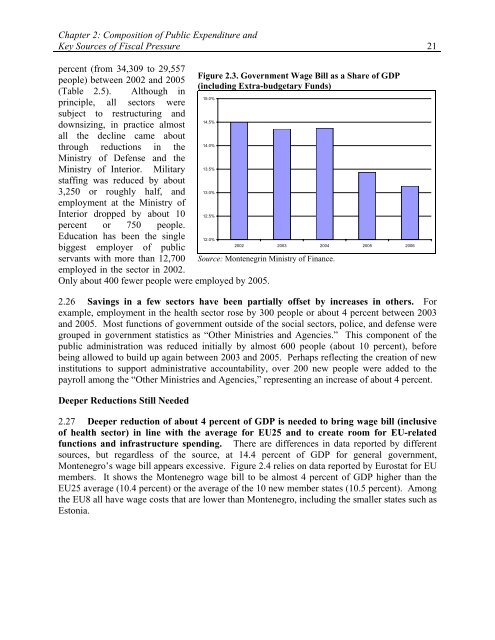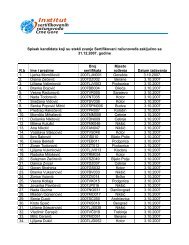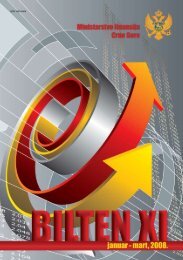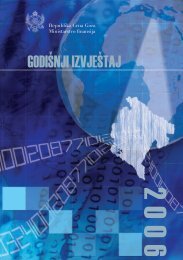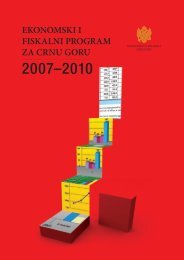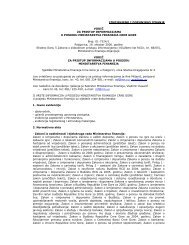Republic of Montenegro: Public Expenditure and ... - Vlada Crne Gore
Republic of Montenegro: Public Expenditure and ... - Vlada Crne Gore
Republic of Montenegro: Public Expenditure and ... - Vlada Crne Gore
You also want an ePaper? Increase the reach of your titles
YUMPU automatically turns print PDFs into web optimized ePapers that Google loves.
Chapter 2: Composition <strong>of</strong> <strong>Public</strong> <strong>Expenditure</strong> <strong>and</strong><br />
Key Sources <strong>of</strong> Fiscal Pressure 21<br />
percent (from 34,309 to 29,557<br />
Figure 2.3. Government Wage Bill as a Share <strong>of</strong> GDP<br />
people) between 2002 <strong>and</strong> 2005<br />
(including Extra-budgetary Funds)<br />
(Table 2.5). Although in<br />
15.0%<br />
principle, all sectors were<br />
subject to restructuring <strong>and</strong><br />
downsizing, in practice almost<br />
14.5%<br />
all the decline came about<br />
through reductions in the<br />
14.0%<br />
Ministry <strong>of</strong> Defense <strong>and</strong> the<br />
Ministry <strong>of</strong> Interior. Military<br />
13.5%<br />
staffing was reduced by about<br />
3,250 or roughly half, <strong>and</strong> 13.0%<br />
employment at the Ministry <strong>of</strong><br />
Interior dropped by about 10 12.5%<br />
percent or 750 people.<br />
Education has been the single<br />
biggest employer <strong>of</strong> public<br />
servants with more than 12,700<br />
12.0%<br />
Source: Montenegrin Ministry <strong>of</strong> Finance.<br />
employed in the sector in 2002.<br />
Only about 400 fewer people were employed by 2005.<br />
2.26 Savings in a few sectors have been partially <strong>of</strong>fset by increases in others. For<br />
example, employment in the health sector rose by 300 people or about 4 percent between 2003<br />
<strong>and</strong> 2005. Most functions <strong>of</strong> government outside <strong>of</strong> the social sectors, police, <strong>and</strong> defense were<br />
grouped in government statistics as “Other Ministries <strong>and</strong> Agencies.” This component <strong>of</strong> the<br />
public administration was reduced initially by almost 600 people (about 10 percent), before<br />
being allowed to build up again between 2003 <strong>and</strong> 2005. Perhaps reflecting the creation <strong>of</strong> new<br />
institutions to support administrative accountability, over 200 new people were added to the<br />
payroll among the “Other Ministries <strong>and</strong> Agencies,” representing an increase <strong>of</strong> about 4 percent.<br />
Deeper Reductions Still Needed<br />
2002 2003 2004 2005 2006<br />
2.27 Deeper reduction <strong>of</strong> about 4 percent <strong>of</strong> GDP is needed to bring wage bill (inclusive<br />
<strong>of</strong> health sector) in line with the average for EU25 <strong>and</strong> to create room for EU-related<br />
functions <strong>and</strong> infrastructure spending. There are differences in data reported by different<br />
sources, but regardless <strong>of</strong> the source, at 14.4 percent <strong>of</strong> GDP for general government,<br />
<strong>Montenegro</strong>’s wage bill appears excessive. Figure 2.4 relies on data reported by Eurostat for EU<br />
members. It shows the <strong>Montenegro</strong> wage bill to be almost 4 percent <strong>of</strong> GDP higher than the<br />
EU25 average (10.4 percent) or the average <strong>of</strong> the 10 new member states (10.5 percent). Among<br />
the EU8 all have wage costs that are lower than <strong>Montenegro</strong>, including the smaller states such as<br />
Estonia.


